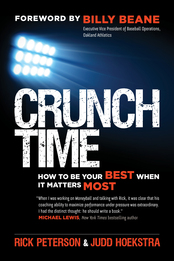When Facing Pressure, Don’t Just Try to Survive; Learn to Thrive!
 This guest post is by Judd Hoekstra, Blanchard vice president and coauthor of the new book, Crunch Time, just released on Monday.
This guest post is by Judd Hoekstra, Blanchard vice president and coauthor of the new book, Crunch Time, just released on Monday.
In today’s hypercompetitive world, we all face significant pressure to perform. We want to be our best when it matters most. But something happens when the pressure rises. In too many cases, we get in our own way and perform far below our capabilities.
When we’re under pressure, we can think about the situation in one of two ways—either as a threat or as an opportunity. Seeing the pressure situation as a threat cripples our performance. Seeing the pressure situation as an opportunity helps our performance.
Here’s the problem: Our reflexive, instinctual reaction is to perceive pressure situations as threats. While this fight, flight, or freeze reflexive reaction serves as valuable protection to survive physical threats, it hurts us when applied to most modern-day pressure situations where the threats are psychological in nature.
Fortunately, there is a solution. In writing Crunch Time, I teamed up with former Major League Baseball pitching coach Rick Peterson to share the secret to being your best when it matters most.
What does a pitching coach know about pressure? A pitching coach is the only coach in professional sports who provides in-game coaching on the field of play. He must calm his pitcher down with millions of people watching, with the game on the line, in 30 seconds or less. Also, everyone watching will know within minutes whether or not the coaching worked. See YouTube clip.
What’s the secret of clutch performers? Reframing. At its core, reframing describes the skill of consciously and intentionally thinking about a situation from one or more different perspectives. Reframing isn’t about donning rose-colored glasses or pretending everything is fine when it’s not. It’s about finding different ways of interpreting a sticky situation. The resulting new frame leads to a different meaning, which leads to better actions, and better results.
Better Thoughts & Emotions -> Better Actions -> Better Results
Consider the following example. When President Ronald Reagan was running for reelection in 1984, he was the oldest president to have ever served. At age 73, there were many questions about Reagan’s capacity to endure the grueling demands of the presidency. On October 7, Reagan performed poorly in the first debate against his opponent, Democratic candidate Walter Mondale. Among other mistakes, Reagan admitted to being “confused.”
Two weeks later, in the next debate, Mondale made a comment that implied Reagan’s advanced age was an issue voters should be concerned about. Reagan’s comeback was priceless. He joked, “I will not make age an issue of this campaign. I am not going to exploit, for political purposes, my opponent’s youth and inexperience.” Mondale himself laughed at Reagan’s joke. With that humorous reframe, Reagan effectively neutralized the age issue, ended Mondale’s campaign, and steamrolled to reelection. See YouTube clip.
Learn to thrive under pressure by reframing from trying harder to trying easier, from tension to laughter, from anxiety to taking control, from doubt to confidence, from failure to a learning moment, and from prepared to overprepared. Should you have any doubt about the value of reframing pressure, consider the following:
- Reframing is not a matter of “you have it or you don’t.” It’s a skill that can be learned.
- Reframing is a powerful life hack that doesn’t take hours to master. While the 10,000-hour rule to master a new skill is true for many skills, who has 10,000 hours to spare? Reframing is as quick as coming up with a new thought.
- In addition to being quick, reframing is efficient. It redirects your attention away from what could go wrong and toward the opportunity before you.
- Unlike dunking a basketball or becoming a supermodel, reframing is not limited to those who have won the genetic lottery. You don’t need to be rich, well-educated, or ultra-talented. Reframing is available to everyone.
- Reframing can help you anytime, anywhere. The skill resides in our mind: you don’t need to be in an office, or in front of a laptop or smartphone.
- Reframing applies in any pressure situation. It applies at work as you seek to solve problems, make presentations, or beat your quota. It applies in your personal life as you sing a solo in the church choir or play in a big golf match.
- In addition to being a skill you can use to help yourself, reframing is a key skill you can use to coach and positively influence others.
At crunch time, you can experience the pain of choking or the pure joy of coming through in the clutch. By reading Crunch Time, you’ll have the knowledge, skill, and confidence you need to consistently be your best when it matters most.
About the Author
 Judd Hoekstra is a leadership and human performance expert, sales executive, bestselling author and speaker. Crunch Time, Judd’s most recent book coauthored with professional baseball pitching coach Rick Peterson, reveals the secrets of how to perform your best under pressure. For additional resources and to download a free book excerpt, go to www.juddhoekstra.com.
Judd Hoekstra is a leadership and human performance expert, sales executive, bestselling author and speaker. Crunch Time, Judd’s most recent book coauthored with professional baseball pitching coach Rick Peterson, reveals the secrets of how to perform your best under pressure. For additional resources and to download a free book excerpt, go to www.juddhoekstra.com.
